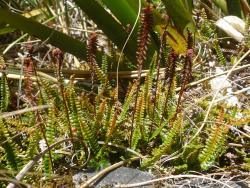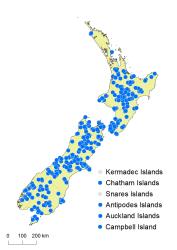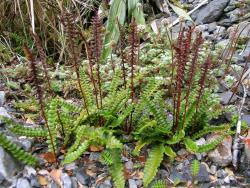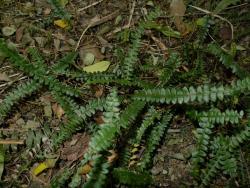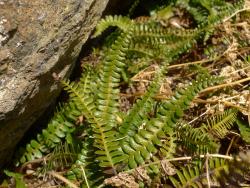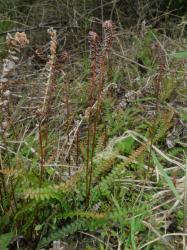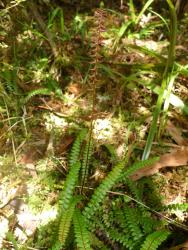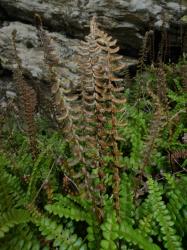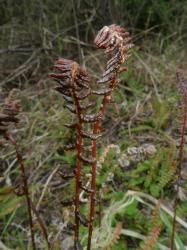- ≡ Stegania alpina R.Br., Prodr. Fl. Nov. Holland. 152 (1810)
- ≡ Lomaria alpina (R.Br.) Spreng., Syst. Veg., ed. 16, 4, 62 (1827)
- ≡ Blechnum alpinum (R.Br.) Mett., Fil. Hort. Bot. Lips. 64 (1856)
- ≡ Austroblechnum penna-marina subsp. alpina (R.Br.) A.R.Field, Austral. Syst. Bot. 33: 59 (2020)
- = Lomaria linearis Colenso, Tasmanian J. Nat. Sci. 1: 376 (1843)
- = Lomaria pumila Raoul, Ann. Sci. Nat., Bot. sér. 3, 2: 115 (1844) nom. illeg., non Lomaria pumila Kaulf. 1824
- ≡ Spicanta pumila (Raoul) Kuntze, Revis. Gen. Pl. 2, 822 (1891)
- = Lomaria parvifolia Colenso, Trans. & Proc. New Zealand Inst. 20: 224 (1888)
- ≡ Blechnum parvifolium (Colenso) C.Chr., Index Filic. 157 (1905)
- = Lomaria distans Colenso, Trans. & Proc. New Zealand Inst. 28: 615 (1896)
- ≡ Blechnum hillii C.Chr., Index Filic. 155 (1905) nom. nov. pro Lomaria distans Colenso 1896
- ≡ Struthiopteris distans (Colenso) Ching, Sunyatsenia 5: 243 (1940)
Rhizomes short- to long-creeping, up to 250 mm long (in herbarium material), bearing scales. Rhizome scales ovate or triangular, 1.3–3 mm long, 0.6–1.8 mm wide, pale brown, concolorous. Fronds strongly dimorphic; sterile fronds 15–400 mm long, prostrate or semi-erect; fertile fronds on same plant longer, 35–430 mm long, up to twice the length of the sterile, held erect. Sterile fronds. Stipes 5–190 mm long, red-brown, bearing scales that become more scattered distally. Rachises yellow-brown, grooved adaxially, glabrous or with a few scattered scales. Laminae 10–235 mm long, 3–25 mm wide, pinnatisect, linear to narrowly elliptic, tapering to a pinnatifid apex, similar colour on both surfaces, coriaceous, glabrous or with a few scattered scales. Pinnae in 12–44 pairs, closely spaced, triangular or oblong, straight, gradually reducing to the lamina base; the longest pinnae at or about the middle, 2–13 mm long, 1–6 mm wide, apices acute to obtuse, margins entire or shallowly dentate, bases adnate; the basal pinnae ± opposite. Veins free. Fertile fronds. Stipes 15–280 mm long. Laminae 15–240 mm long, 4–18 mm wide. Pinnae in 10–36 pairs, linear to narrowly oblong, falcate or straight, the longest 2–9 mm long, 1–3 mm wide, replaced by tiny sterile flanges at the lamina base. Sori and indusia in one row either side of costa, continuous along the length of the pinna.
Blechnum penna-marina subsp. alpina is characterised by its dimorphic fronds, free veins, pinnatisect sterile laminae, and continuous sori. It has a creeping rhizome, and sterile laminae that are linear to narrowly elliptic, bearing oblong or triangular pinnae with entire or shallowly dentate margins. The basal pinnae are usually opposite. The fertile fronds are up to twice as long as the sterile. The general shape and dimensions of the laminae in B. penna-marina subsp. alpina are similar to those of B. banksii and B. membranaceum, but B. penna-marina is distinguished by its creeping rhizome and much longer fertile fronds.
North Island: Northland, Auckland, Volcanic Plateau, Gisborne, Taranaki, Southern North Island.
South Island: Western Nelson, Sounds-Nelson, Marlborough, Westland, Canterbury, Otago, Southland, Fiordland.
Chatham Islands, Stewart Island, Antipodes Islands, Auckland Islands, Campbell Island.
Altitudinal range: 0–1900 m.
In the North Island Blechnum penna-marina subsp. alpina is common in lowland to alpine areas from Hamilton and East Cape south to Wellington, with outlying populations near Warkworth, and at Ahipara. It ranges from near sea level up to 1375 m on Mt Taranaki and in the Ruahine Ranges. It is common in lowland to alpine areas throughout the South Island and Stewart Island. It grows from near sea level up to 1900 m in the Spenser Mountains, Nelson. It also extends to the Chatham Islands and most of the subantarctic islands.
Also Australia (New South Wales, Victoria, Tasmania), Macquarie Island, Chile, Argentina, Falkland Islands (Chambers & Farrant 1996).
Blechnum penna-marina subsp. alpina is a terrestrial fern found in podocarp, broadleaved and beech forest, under mānuka and Salix species, in pine forest, in Sphagnum bog and wet pasture, and in subalpine scrub, tussock grassland and rocky herbfield. It grows on creek banks and in creek beds, on river terraces, at forest margins, along tracksides and roadsides, on clay banks, among rocks and scree, in dune hollows and coastal turf, in swamps and on peaty soils, and in subalpine habitats.
n = 34 (Brownlie 1954), 2n = 66 (Chambers 1954; Chambers & Farrant 1996).
Jeßen & Lehmann (2018) attempted to make the new combination Austroblechnum penna-marina subsp. alpina but incorrectly cited the basionym of the subspecific epithet as Chambers & Farrant (1996), rather than Brown (1810). They also failed to provide the date and place of publication of Brown’s basionym, and hence their combination was not validly made. The combination was correctly made by Field (2020).



